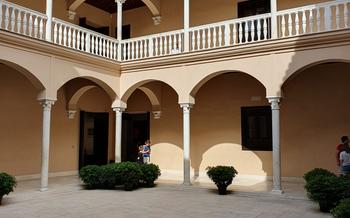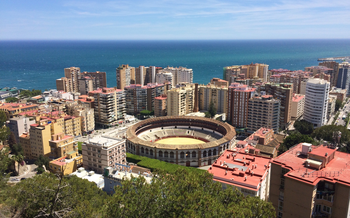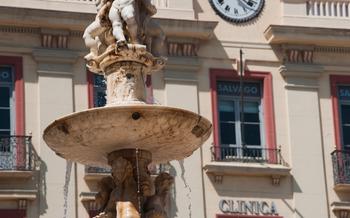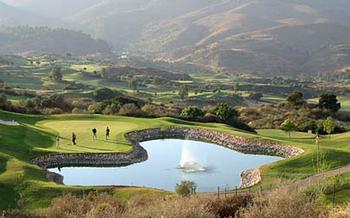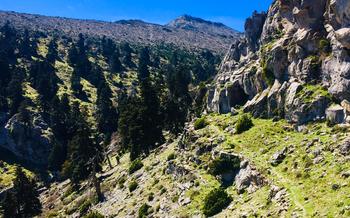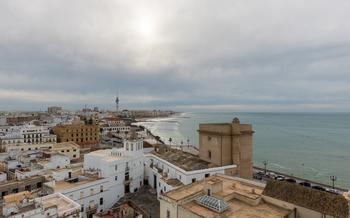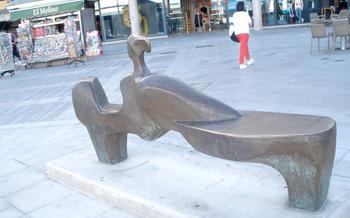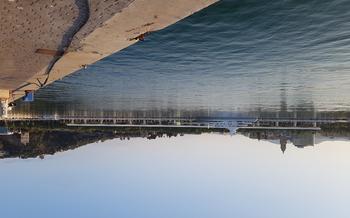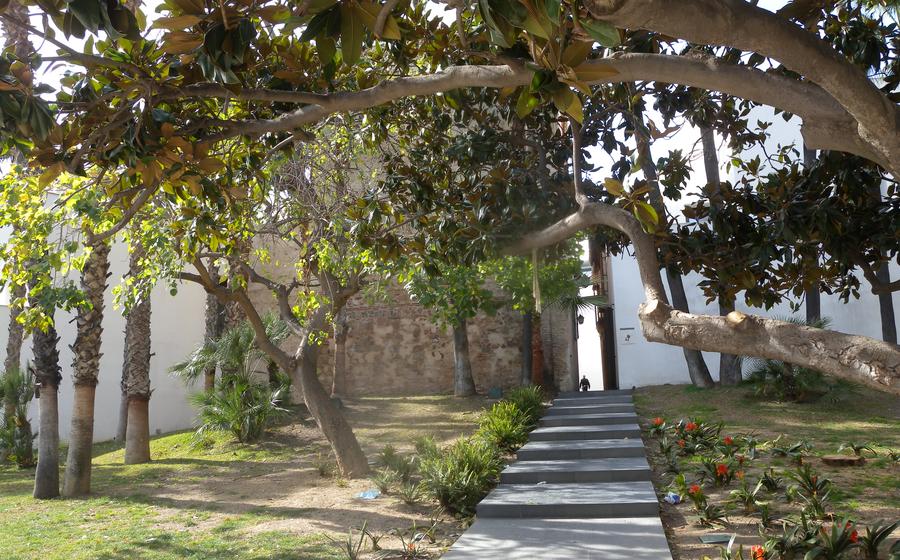
Hoya de las Cabras Park (University Campus)
- Hoya de las Cabras Park: A Haven for Nature Lovers
- Location and Accessibility
- Hours of Operation
- Things to Do in the Park
- Plant Life and Biodiversity
- Wildlife Encounters
- Geological Formations
- Educational Opportunities
- Accessibility for All
- Sustainable Practices
- Nearby Attractions: Exploring Beyond the Park's Boundaries
- Food and Beverages
- Insider Tip: Unveiling the Park's Hidden Charms
Hoya de las Cabras Park: A Haven for Nature Lovers
** Cabras Park serves as a hidden gem, a tranquil oasis amidst the bustling city.** Once a natural quarry, the park has been meticulously transformed into a haven for nature enthusiasts, offering a sanctuary for diverse flora and fauna.
With its inception dating back to 2015, the park has become a testament to the harmonious coexistence of nature and academia. Spanning over 90,000 square meters, the park boasts a rich tapestry of landscapes, from lush Mediterranean vegetation to rugged rock formations, creating a captivating mosaic of natural wonders.
Location and Accessibility
The Hoya de las Cabras Park is strategically located within the University Campus of Málaga, making it easily accessible to students, staff, and visitors. The park's entrance is situated on the northwestern side of the campus, adjacent to the Faculty of Veterinary Science.
To reach the park by public transportation, visitors can take bus line 11, which stops right outside the park entrance. The nearest metro station is El Cónsul, which is about a 15-minute walk from the park.
For those arriving by car, there is ample parking available within the university campus. Visitors can park in the designated parking areas near the Faculty of Veterinary Science or in the general parking lot located at the entrance of the campus.
The park is open to the public daily, and admission is free of charge. However, guided tours are available for groups and educational institutions, with fees varying depending on the size of the group and the duration of the tour.
The best time to visit Hoya de las Cabras Park is during the spring or fall, when the weather is pleasant and the park is in full bloom. However, the park offers a unique experience in every season, with the vibrant colors of autumn, the tranquility of winter, and the lush greenery of summer.
Hours of Operation
The Hoya de las Cabras Park is generally open to the public during daylight hours, although the exact hours may vary depending on the season and special events. Regular opening hours are usually from 8 am to 8 pm, but it's recommended to check the park's official website or contact the park management for the most up-to-date information.
During the summer months (June to August), the park may extend its hours to accommodate longer daylight hours and increased visitor traffic. On weekends and public holidays, the park is often busier, so it's a good idea to arrive early to avoid crowds and fully enjoy the tranquility and serenity of the park.
If you're planning to visit during the winter months (December to February), be aware that the park may have reduced hours or even close for a period due to weather conditions and maintenance. It's always advisable to check beforehand to avoid any disappointment.
The best time to visit the park is in the early morning or late afternoon when the temperatures are milder, and the lighting is ideal for photography and wildlife watching. However, the park offers a unique charm and beauty at any time of day, so it's worth visiting whenever you can.
Things to Do in the Park
Explore Hiking Trails: The park boasts a network of well-marked hiking trails catering to different skill levels. Trek through dense vegetation, discover hidden waterfalls, and enjoy panoramic vistas. Choose from easy, moderate, or challenging trails, each offering unique perspectives of the park's natural beauty.
Wildlife Watching: Hoya de las Cabras Park is a haven for wildlife enthusiasts. Keep your eyes peeled for elusive birds, graceful deer, and playful rabbits. The park's diverse ecosystem supports a rich array of fauna, from the tiniest insects to majestic birds of prey. Bring your binoculars and immerse yourself in the vibrant wildlife spectacles.
Picnicking and Dining: Pack a delightful picnic and head to one of the designated picnic areas within the park. Enjoy a leisurely feast surrounded by nature's tranquility. Alternatively, savor local delicacies at the park's charming restaurant, offering a menu inspired by regional flavors.
Adventure Activities: For those seeking an adrenaline rush, the park offers thrilling adventure activities. Soar through the air on a zip-line, experiencing breathtaking views of the surrounding landscape. Challenge yourself with a rock-climbing session on the park's natural rock formations.
Plant Life and Biodiversity
Hoya de las Cabras Park is home to a diverse array of plant life, including many unique and rare species. The park's Mediterranean climate and varied terrain create an ideal habitat for a wide range of flora. Visitors can explore the park's many trails and discover a variety of native plants, including aromatic herbs like thyme, rosemary, and lavender. The park is also home to several medicinal plants, such as chamomile, sage, and valerian.
One of the most interesting aspects of the park's flora is the presence of several endemic species, which are found nowhere else in the world. These include the Malaga daisy, a vibrant yellow flower that blooms in the spring, and the Hoya de las Cabras rock rose, a small shrub with delicate pink flowers.
The park's plant life is not only beautiful but also plays a vital role in the ecosystem. The plants provide food and shelter for a variety of animals, and they help to regulate the water cycle and prevent erosion. The park's staff is dedicated to protecting the park's flora, and they work to control invasive species and promote the growth of native plants.
Personal Story:
During my visit to the park, I was fortunate enough to discover a rare orchid growing in a secluded corner of the park. The orchid was a beautiful shade of purple, and it was the first time I had ever seen one in the wild. I was amazed by its beauty and its resilience, as it had managed to thrive in such a harsh environment.
Wildlife Encounters
The Hoya de las Cabras Park offers a remarkable wildlife experience, with a diverse range of animal species inhabiting its landscapes. Commonly spotted mammals include rabbits, foxes, and badgers, while reptiles like lizards and snakes can be seen basking in the sun. The park is also home to numerous bird species, with many migratory birds making a stop during their seasonal journeys. Keep an eye out for the majestic eagle soaring overhead or the colorful bee-eaters flitting through the trees.
Among the highlights of the park's wildlife are the endangered species that find refuge within its boundaries. The Iberian lynx, one of the world's most critically endangered felines, has been successfully reintroduced to the park, and visitors may be fortunate enough to catch a glimpse of these elusive creatures. The park also provides a habitat for the Bonelli's eagle, a rare and protected bird of prey.
For birdwatchers, the Hoya de las Cabras Park is a paradise. Over 150 species have been recorded in the park, including the blue rock thrush, the hoopoe, and the golden oriole. The park's diverse habitats, from forests to wetlands, provide nesting and feeding grounds for a variety of birds, making it an ideal destination for birdwatching enthusiasts.
During my visit to the park, I was fortunate enough to witness a truly memorable wildlife encounter. As I was hiking along one of the trails, I stumbled upon a family of wild boars foraging in the undergrowth. The adult boars were massive, with their bristly fur and sharp tusks, while the piglets were adorable, scampering around and playing in the leaves. It was a magical moment to observe these magnificent creatures in their natural habitat, and it left me with a deep appreciation for the rich biodiversity of the Hoya de las Cabras Park.
Geological Formations
Hoya de las Cabras Park boasts fascinating geological formations that have shaped its unique landscape over millions of years. The park's geology is a testament to the Earth's dynamic processes and the power of erosion and weathering. Visitors can explore towering rock formations, deep ravines, and intricate cave systems, each telling a story of the park's geological past.
The park is home to a variety of rock types, including limestone, sandstone, and conglomerate. These rocks have been shaped by water, wind, and ice over time, creating stunning features like the Cueva del Agua cave, with its impressive stalactites and stalagmites, and the Risco del Aguila, a towering rock formation that offers breathtaking views of the surrounding countryside.
One of the most striking geological formations in the park is the Hoya de las Cabras, a large depression that was formed by the collapse of a limestone cave. The Hoya is surrounded by steep cliffs and is home to a variety of plant and animal life, making it a microcosm of the park's diverse ecosystem.
For those interested in geology, Hoya de las Cabras Park offers a wealth of opportunities to explore and learn. Visitors can follow the park's numerous hiking trails, which wind through different geological formations and provide interpretive signage explaining the park's geological history. Guided tours are also available, led by experienced geologists who can provide insights into the park's unique geological features.
Educational Opportunities
Enhancing the park's ecological allure is its dedication to education and scientific research. Visitors can embark on guided tours designed to illuminate the park's natural wonders, providing insights into its geological formations, flora, and fauna. Interactive exhibits and workshops further engage visitors, allowing them to delve deeper into the park's ecological significance.
My personal experience attending an educational event at the park was both captivating and enlightening. I participated in a guided hike led by a park ranger, who shared fascinating details about the park's unique flora and fauna. The ranger's passion for the park's conservation efforts was infectious, inspiring me to become more actively involved in environmental stewardship.
Accessibility for All
Hoya de las Cabras Park welcomes visitors from all abilities and backgrounds, ensuring an inclusive and enjoyable experience for everyone.
-
Wheelchair-Accessible Trails: Several trails in the park have been specially designed to accommodate visitors using wheelchairs, allowing them to explore the park's natural beauty without barriers.
-
Adapted Tours and Services: The park offers guided tours tailored to the needs of visitors with disabilities, providing detailed descriptions and assistance throughout the tour.
-
Sensory Gardens: The park features sensory gardens designed to stimulate the senses of sight, sound, smell, and touch, offering a unique and immersive experience for visitors with sensory impairments.
-
Inclusive Playgrounds: Children with disabilities can enjoy a fun and safe play experience at the park's inclusive playgrounds, which feature accessible equipment and surfaces.
-
Accessible Restrooms: The park provides accessible restrooms conveniently located throughout the grounds, ensuring easy access for visitors with disabilities.
-
Visitor Assistance: The park staff is trained to assist visitors with disabilities, providing information, directions, and any necessary assistance to ensure a comfortable and enjoyable visit.
By embracing accessibility and inclusivity, Hoya de las Cabras Park strives to create a welcoming and enjoyable environment for all visitors, regardless of their abilities or limitations.
Sustainable Practices
Hoya de las Cabras Park is committed to sustainable practices and environmental conservation. The park actively implements measures to minimize its impact on the ecosystem. Waste management initiatives, such as recycling and composting, are in place to reduce waste generation. Moreover, the park utilizes renewable energy sources like solar and wind power to meet its energy needs.
As a visitor, you can contribute to the park's sustainability efforts by practicing responsible habits. Reduce your waste by bringing reusable water bottles and containers. Dispose of waste properly in designated bins, and avoid littering. Respect the park's natural beauty by staying on designated trails and refraining from picking plants or disturbing wildlife. By embracing sustainable practices, we can collectively preserve this natural haven for future generations.
Nearby Attractions: Exploring Beyond the Park's Boundaries
Hoya de las Cabras Park is strategically located in close proximity to a wealth of other captivating destinations, ensuring that visitors can easily extend their exploration beyond the park's boundaries. For those seeking a comprehensive cultural experience, the historic city of Málaga beckons with its ancient Alcazaba fortress, the majestic Catedral de Málaga, and the renowned Picasso Museum. Art enthusiasts will delight in the vibrant street art scene in the Soho district, while history buffs can delve into the region's past at the Museo de Málaga, which houses a remarkable collection of artifacts from various eras.
Nature lovers can embark on a scenic drive along the scenic Costa del Sol, discovering picturesque coastal towns and breathtaking natural landscapes. The nearby El Torcal de Antequera Natural Park offers a stunning display of karst rock formations, while the Caminito del Rey, a thrilling walkway suspended along the steep cliffs of the El Chorro gorge, promises an unforgettable adventure. For those seeking tranquility, the idyllic beaches of La Cala del Moral and Rincón de la Victoria offer a serene escape, inviting visitors to bask in the warm sunshine and enjoy refreshing swims in the crystal-clear waters.
Food and Beverages
The Hoya de las Cabras Park offers a range of dining options to satisfy every palate. Visitors can enjoy a leisurely picnic amidst the serene surroundings, taking advantage of the designated picnic spots and barbecue facilities. Pack a basket filled with local delicacies, such as the mouthwatering "pescaíto frito" (fried fish) or the traditional "gazpacho" (cold tomato soup).
For those seeking a more substantial meal, the park's restaurant offers a menu featuring regional specialties and international cuisine. Indulge in the flavors of Andalusian gastronomy with dishes like "paella" (rice with seafood and meat) or "salmorejo" (a thick tomato soup).
Don't miss the opportunity to sample the local wines produced in the Málaga region. The park's restaurant offers a carefully curated selection of local vintages, allowing visitors to savor the unique flavors of this wine-growing area.
To fully immerse yourself in the local culinary scene, venture outside the park to explore the nearby restaurants and cafes. Sample the freshest seafood at the traditional "chiringuitos" (beach bars) along the coast or savor the regional cuisine in the charming restaurants of Málaga city.
Insider Tip: Unveiling the Park's Hidden Charms
For an unforgettable experience, venture off the beaten path and discover the park's hidden gems. Seek out the secluded viewpoint near the eastern edge of the park, where you'll be rewarded with panoramic vistas of the surrounding mountains and the glistening Mediterranean Sea. If you're a keen photographer, arrive early to capture the magical glow of sunrise as it illuminates the landscape.
To escape the crowds and immerse yourself in nature's tranquility, plan your visit during the shoulder season, typically from April to May or September to October. The park transforms into a haven of tranquility, offering a unique opportunity to connect with nature without the hustle and bustle of peak season.
Don't miss the opportunity to explore the park's secret botanical garden, nestled away from the main trails. This hidden oasis showcases a diverse collection of native and exotic plants, including rare and endangered species. Take your time to wander through the garden, admiring the vibrant colors and delicate fragrances that fill the air.
Remember, the park is a treasure trove of hidden wonders waiting to be discovered. Embrace the spirit of exploration, venture beyond the familiar paths, and create lasting memories in this enchanting natural paradise.
